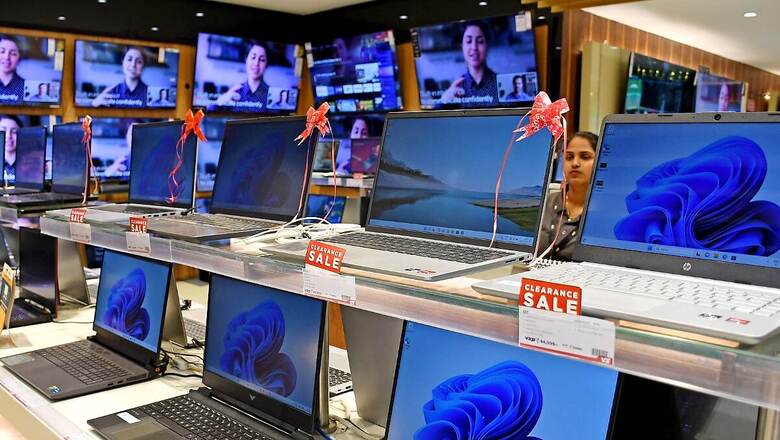
views
Personal computing devices are inseparable parts of our lives: for professionals, for students, and for families to connect to personal, social, and work spheres we exist in. Most of these personal computing devices have Chinese origins. Data from Counterpoint Research shows that 286 million personal computing devices (desktops, notebooks, and workstations) were shipped globally in 2022. Lenovo, a Chinese company, was the biggest global maker of personal computing devices, followed by HP, Dell, Apple, and Asus.
A research report published by S&P in April 2023 says that 80% of the world’s laptops are produced in China, representing Chinese domination in electronics manufacturing overall. According to the Economist magazine, of the total global trade of USD 3.3 trillion in 2021, the share of Chinese exports of electronic goods and components amounted to USD 1 trillion.
Like most other countries, India is also dependent on China when it comes to IT hardware. Data from Counterpoint Research suggests that around 67% of personal computing devices are imported into India, with China being the main source, accounting for 75% of the total imports, according to data from the Ministry of Commerce, Government of India. This situation results in almost total dependence, which can severely impact India or any other country during conflicts or global health crises like Covid, leading to extended global lockdowns for many months.

To foster self-dependency in this sector, the government introduced a production-linked incentive (PLI) scheme for IT hardware (laptops, tablets, all-in-one PCs, servers, and ultra-small form factor (USFF) desktops) in 2021. The aim was to reduce dependence on Chinese suppliers, achieve self-reliance, and establish India as a future manufacturing hub for high-tech IT hardware for other countries.
Incentives were announced for companies based on increasing local production and incremental sales volume. Through the PLI scheme, the primary focus was to initially boost local assembly lines for various imported components of personal computing devices in India, followed by promoting their local production in subsequent steps.
In the first phase, the Government of India allocated an outlay of Rs 7,350 crore, which was increased to Rs 17,000 crore in PLI 2.0. The average incentives were also raised to 5.3% from 2.2% to encourage companies.
The first edition largely failed as companies claimed that the incentives provided were inadequate, but it should be perceived more as a pilot phase. Fourteen companies were approved for PLI 1.0, yet only two companies, Dell and Bhagwati, managed to meet the 2021-22 targets. Most internal components of personal computing devices are imported, and companies required more incentives to transition to a local manufacturing system in India. Recognizing the issues in the initial stage, the government launched a broader initiative in the form of PLI 2.0.
With PLI 2.0, the expected incremental production value is around Rs 3.5 lakh crore. The initiative is also projected to create approximately 2 lakh jobs, including 50,000 in direct employment and 150,000 in indirect employment, with an expected incremental investment of Rs 3,000 crore under PLI 2.0.
Thirty-eight companies applied for it, and the names of 27 companies, including Dell, HP, Flextronics, Foxconn, Acer, Asus, and Lenovo, were approved. The government states that 23 companies are ready to begin production on day zero, with the remaining four expected to commence within the next three months. The PLI 2.0 initiative envisions a gradual evolution, starting from the assembly of foreign components to their local production, aiming to establish India as a significant IT hardware manufacturing base for other countries.
ONE MORE STEP TOWARDS A SECURE FUTURE
In August 2023, citing security risks, the Government of India mandated a compulsory import license for PC imports. Initially scheduled for implementation from November 1, it was later postponed after objections from the industry. India aims to restrict the import of personal computing devices (personal computers, laptops, palmtops, automatic data processing machines, microcomputers, or processors, and large or mainframe computers) with immediate effect, but is now exploring alternative mechanisms for implementation.
Though not explicitly stated, China was the primary reason behind this license, as India is currently heavily reliant on China for IT hardware. Future imports are anticipated only from trusted partners with a valid import license from the Government of India. Certain hardware used in personal computing devices could potentially compromise sensitive and personal data of end users.

















Comments
0 comment